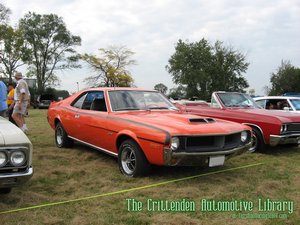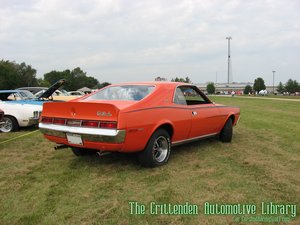















Mark Donohue |
|---|


|
| Topic Navigation |
|---|
|
Wikipedia: Mark Donohue
Page Sections Biography Photographs |
Biography
The following section is an excerpt from Wikipedia's Mark Donohue page on 27 June 2017, text available via the Creative Commons Attribution-ShareAlike 3.0 Unported License.
Born in Haddon Township, New Jersey, Donohue grew up in Summit, graduated from the Pingry School in Hillside, and entered Brown University in Providence, Rhode Island. At the age of twenty-two, while a senior at Brown, Donohue began racing his 1957 Corvette. He won the first event he entered, a hillclimb in Belknap County, New Hampshire. He graduated from Brown in 1959 with a bachelor's degree in mechanical engineering.
Donohue won the SCCA national championship in an Elva Courier in 1961. An experienced race driver named Walt Hansgen recognized Donohue's ability and befriended him, eventually providing an MGB for Donohue to race at the 1964 Bridgehampton 500-mile (800 km) SCCA endurance event, which he won. Hansgen arranged for Donohue to become his teammate in 1965, co-driving a Ferrari 275 at the 12 Hours of Sebring endurance race, which they finished in 11th place. That year, Donohue also won two divisional championships: in SCCA B Class in a GT350 and in SCCA Formula C in a Lotus 20B.
Donohue was hired on March 29, 1964 by Jack Griffith [Griffith Motors, Syosset, N.Y./Plainview, N.Y.] as design engineer for the Griffith, formerly TVR Grantura Mk III, powered by a Ford 289 cid (4.7l) V8 engine. He went on to assist TVR's David Hives in designing the Series 400 Griffith and then working on the ill-fated Bob Cumberford-designed, Intermeccanica-(Torino, Italy) produced Series 600 Griffith. During its production life, there were 192 Series 200 Griffiths built, 59 of the Series 400 and only 10 of the Series 600. During his stay at Griffith Mark drove the Griffith-owned Shelby 289 Cobra making his mark on the SCCA circuit. In February of '65 Donohue was named as comptroller at Griffith Motors but was soon spirited away from Griffith by Roger Penske early in 1966. The Griffith company closed its doors in November, 1966.
Midway through the 1975 F1 season, Penske abandoned the troublesome PC1 and started using the March 751. Donohue recently had arrived in Austria for the Austrian Grand Prix at the Österreichring race track following the successful closed-course speed record attempt at Talladega Superspeedway in Alabama just a few days earlier. During a practice session for the race, Donohue lost control of his March after a tire failed, sending him careening into the catch fencing at the fastest corner on the track, Vöest Hügel Kurve. A track marshal was killed by debris from the accident, but Donohue did not appear to be injured significantly. It is said that Donohue's head struck either a catch fencing post or the bottom of the wood frame for an advertising billboard located alongside of the racetrack. A headache resulted, however, and worsened. After going to the hospital of Graz the next day, Donohue lapsed into a coma from a cerebral hemorrhage and died. He was survived by his wife and two sons from his first marriage. Donohue is buried at St. Teresa Cemetery in Summit, New Jersey.
 |
Mark Donohue SST Photo ©2007 John Walczak Lensing Autumn Classic Car Show October 7, 2007 View photo of Mark Donohue AMC Javelin - 3,417KB |
 |
Mark Donohue SST Photo ©2007 John Walczak Lensing Autumn Classic Car Show October 7, 2007 View photo of Mark Donohue AMC Javelin - 3,105KB |
